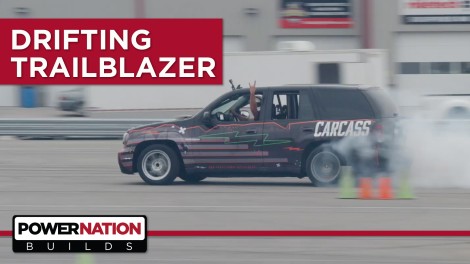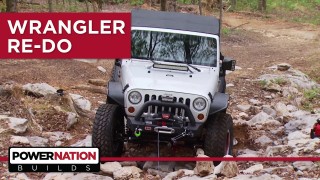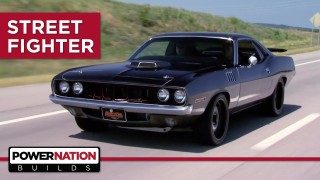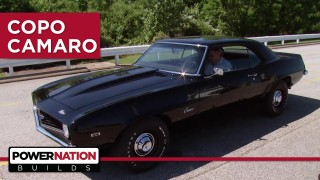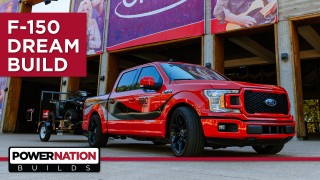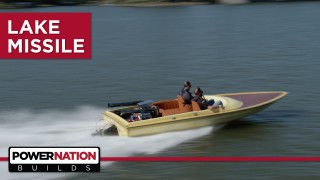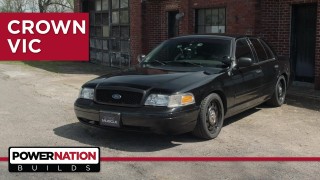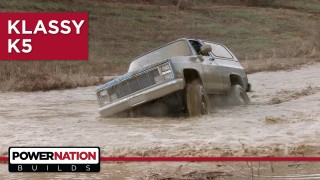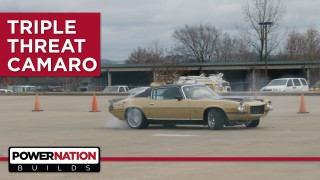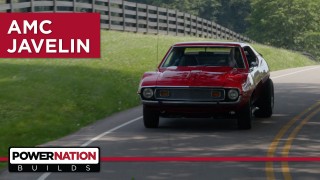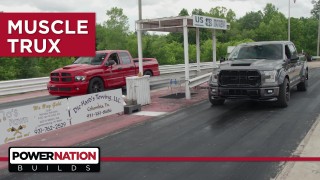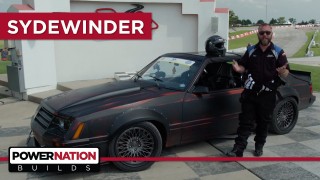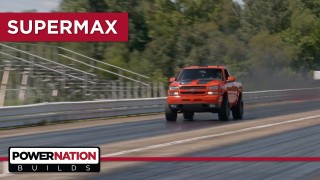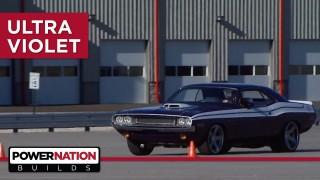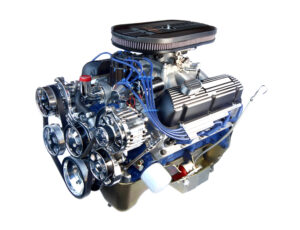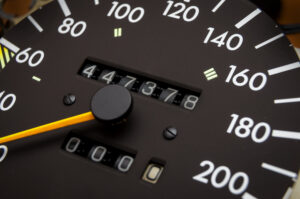Want more content like this?
Join the PowerNation Email NewsletterVideo Transcript
(Jeremy)>> You're watching Powernation.
[ Music ]
(Katie)>> Welcome to Powernation Builds. Today's big question is can you build a four-door s-u-v drift truck? Well let's find out, here's Carcass!
[ Music ]
(Jimmy)>> This is our 2006 Trailblazer SS. It's the super sport s-u-v from the bowtie brigade sporting some serious boosts in performance.
(Jeremy)>> That's right, this mid-size s-u-v was an exciting new variation of a proven platform that GM had from 2001 to about 2009 but was later replaced by the Traverse. [ Music ]
(Jimmy)>> I think this is gonna be my favorite build this year and this thing is already pretty capable as is.
(Jeremy)>> Totally, and we are gonna have a blast making this thing literally drive sideways.
(Jimmy)>> And you know what's better than drifting with just one friend? Drifting with the whole family.
(Jeremy)>> Yep you heard right. We're gonna take this already capable two wheel drive Trailblazer SS and make it even more sporty, turning it into a four door drift truck. We're gonna tear out the interior, cage the inside, and put in some proper racing seats and harnesses. Then we're gonna throw in a whole new powertrain converting this thing from an automatic to a manual transmission, and finally we'll address our steering and our suspension, making this thing a capable drift machine.
(Jimmy)>> This thing weighs over two tons, and we would like to save somewhere in the ballpark of about 500 pounds. So to do that we're gonna have to rip out everything we can get our hands on inside the cab. One of the heaviest things in the cab are the seats, and since we're bringing some friends along these seats just aren't suitable anymore for this application.
(Jeremy)>> I'll go through! Get skinny!
(Jimmy)>> We aren't gonna leave much behind in the cab. We're gonna remove the center console, all the door seal plates, and any of the plastic trim. Panel after panel we're removing anything and everything we can get our hands on to lighten up the load. Even the headliner has to go.
(Jeremy)>> That's right, the only thing we really want to keep is the dash. So we'll take a little bit of extra time removing it.
(Jimmy)>> With the truck in this state we now have a clean canvas to start our work. Before I even get started on the roll cage I need to figure out where the main hoop is gonna land, and to do that I'm gonna use these blocks, set one of our racing seats on top at the farthest point back from the pedals in case we have a tall driver, and what this is gonna do is push the main hoop as far back as it needs to go so I can get started building.
(Jeremy)>> All we need to do from here is weld up a simple but strong box to support our main hoops.
(Jimmy)>> This method for building out the plinth box works the same as just welding a base plate to the floor to help spread the load over a large area to prevent failure of our roll cage, and it has the advantage of giving us access to all the weld seams.
(Jeremy)>> With that in mind we can now construct our cage starting with our main hoops. We'll position one behind the front seat utilizing a 75 and 15 degree bend, and then we'll place a secondary hoop behind the passenger seats cause we want our friends in back to be just as safe as we are up front.
(Jimmy)>> Next we need to install the side hoops. Each of these is set on the plinth box and the other end is notched to be married to the main hoop. We'll work our way back and tack these into place.
(Jeremy)>> The last pieces to be installed on this jungle gym are the diagonal brace and the door bars. That will help provide some triangulated strength and protect the passengers from any lateral impacts.
(Jimmy)>> We're now ready to finish weld all of our joints, and we have very little room between the top of the cage and the roof. So it'll be impossible to get a tig torch up in that tiny space. This is where our plinth box design comes into play. All we have to do is slide the cage back a few inches, allowing it to drop almost four inches, and that'll give us the ability to weld around each joint.
(Jeremy)>> With the front portion of our cage welded solid all we have to do is set it back on the plinth boxes, add a bar connecting the rear hoop to the front hoop, and make this a permanent part of our Trailblazer. We need to modify the dash so it can fit around the roll cage we just installed. With an idea of how much room we need those measurements will be transferred to the top of our dash and then we'll just start cutting. With our cuts made we'll check to see if it fits. We'll keep an eye out for clearances around the down bars and to see if the dash lines up with the original bolt holes.
(Jimmy)>> Fortunately we only had to make one cut here with everything fitting like a glove, and with a half a dozen bolts holding it in place we can add some creature comforts like a/c controls, and even the radio just for looks.
(Jeremy)>> One thing that we are re-installing that's for more than just looks is the dash cluster. We'll be needing that to sneak up on that red line.
(Katie)>> Up next, of course we need some more muscle and a little carbon fiber.
(Jeremy)>> The interior of our four-door drifting machine is nearly complete. Now we're planning on converting this two wheel drive automatic into a six speed manual. So we're gonna have to do some work inside the cab, but before we can get to that we need to yank out this tired old 400 horsepower pony that nearly has 230,000 miles on it and replace it with a brand new 450 horsepower Clydesdale. Holy cow, I don't want to break it but it's half broke already. I got mine. [ Music ]
(Jeremy)>> With a few bolts here and a few hoses there we'll have the intake free from the top of the engine, making plenty of room for us to pull this poor pony free. With our motor mounts loose we can now yank out this washed up race horse. All that leg work we put into prepping the front end, well it's about to pay off, making easy work lifting this 400 pound engine free from its home.
(Jimmy)>> Giddy up ponies! Alright dude!
(Jeremy)>> Alright we can back up like three inches maybe? I'm on on this side. We'll snug up our engine for starters, and then we'll slip in our headers from below and bolt them in up top. With most of the wiring out of the way we can tackle the front accessory drive. An alternator gets thrown into the mix and a final connection can be made. In the cab we'll unbolt and remove the old automatic shifter and using the pilot hole we drilled from the bottom we'll line up a four-inch hole saw and plunge cut a giant hole through the transmission tunnel.
(Jimmy)>> Think we can get it first try?
(Jeremy)>> I don't know. [ Music ] And stop. Now we've got a shifter that's gonna hit.
(Jimmy)>> Installing the transmission is pretty straight forward. We need to marry the input shaft of the transmission with the clutch, carefully guiding this 135 pound beast into position.
(Jimmy)>> To finish up our installation we'll use the stock cross member and bushings, snugging everything up.
(Jeremy)>> Now it's time to get started on our clutch pedal. To get it installed we'll drill out two connecting inch and a half holes in the firewall, checking to make sure that the fittings clear the hole.
(Jimmy)>> Next we'll drill a hole through the bracket we fabbed up and punch it through the floor. Then add the pedal securing it to the bracket. We'll follow that up with a remote reservoir, which will mount in the cab, and connect the hose to the master cylinder.
(Jeremy)>> We'll make the final connection under the vehicle, attaching the clutch line.
(Jeremy)>> Back in the cab we'll attach the new handle bracket to the shifter before we can figure out a solution for the handle. Jimmy's got a great idea for the handle. We're gonna cut up this huge inch and five-sixteenths wrench and weld it to the handle bracket. Then we'll just put it in the cab and see how it acts. This worked out really, really good but can you imagine it as a right hand drive car?
(Jimmy)>> I don't really have any coordination with my left hand.
(Jeremy)>> I got plenty on this side. Dump the clutch ready, one, two, three.
(Jimmy)>> To get our hood looking sporty there's a little prep involved. Carbon fiber is laid down in layers molding to the shape of the hood. So with a thorough cleaning we can start the process.
(Jeremy)>> We'll then apply several coats of wax making sure to gently buff it after each coat. With a good layer of this stuff on we won't have to worry about the carbon fiber sticking to the hood.
(Jimmy)>> With that out of the way we can start working with the material. We're pre-cutting four sections of carbon fiber cloth to size. We're doing this because this will be a fairly quick process and having these on standby will prevent headaches down the road.
(Jeremy)>> We're now ready to lay down our first layer. Spreading it out on the hood we'll use a can of adhesive spray to help hold it in place.
(Jimmy)>> Then we can start mixing the laminating epoxy resin. This is mixed three to one with a hardener. Two part epoxies like this have something called a pot life. This means there's only an effective working time before it becomes less workable or useless and you risk wasting material. The pot life on this epoxy is one hour. So we're gonna have to work quickly to get each layer on.
(Jeremy)>> We're using a squeegee to carefully spread the epoxy covering every square inch of carbon fiber. We'll lay it on thick getting good coverage, and then we'll go over it one more time to remove the excess.
(Jimmy)>> This is repeated again with the second layer, and again with the third, and once more for our final layer of carbon fiber letting the epoxy cure overnight. I think we got it, Johnny on the spot. Good job man. The epoxy has been given ample time to cure and it's time to crack it loose from the mold.
(Jeremy)>> This is why several coats of wax are essential to this process.
(Jimmy)>> Whoa, that's awesome! Seeing the underside of the hood I'm happy to say that our prep work has paid off, but we're not done yet. We need to make the top side of this thing look just as glassy smooth as the bottom side.
(Jeremy)>> This starts with a little scuff sanding. We're using 120 grit to prep for our flow coat.
(Jimmy)>> We're laying on this coat super thick using modified squeegees to spread but allowing it to pool. We'll let gravity do the work of leveling it all out.
(Jeremy)>> With our flow coat having ample time to cure we'll hit it one more time with a d-a and a series of sand paper grits.
(Jimmy)>> Then we'll trim the edges with a cutoff wheel taking care not to over cut. We were lucky that the underside of the mold left a line to follow which corresponds with the edge of the hood.
(Jeremy)>> The last step to this process is to give our carbon fiber hood some u/v protection with a clear coat and we'll let that dry overnight. To mount our hood we need to add a few reinforcements to help hold the hood in place. At the break we'll take two pieces of 20 gauge steel and bend them length wise at 90 degrees.
(Jimmy)>> With those in hand we'll shrink one side and test fit them to make sure they fit the contour of the hood. Then at the band saw we'll cut one of them down the middle removing a chunk so that they'll be able to form an "X" on the hood.
(Jeremy)>> We'll need to trace the metal stiffeners and use those marks to scuff the surface. Then we'll apply some panel bond adhesive and stick our metal reinforcements to the bottom side of the hood.
(Jimmy)>> To finish up this install we'll drill some holes for a hood pin kit we picked up from Summit Racing, installing the plates that prevent the pins from scratching the hood.
(Katie)>> Up next, we're gonna need some upgrades. Plus, it's dyno time!
(Jeremy)>> With everything pretty much off the front of the engine we can move on to the Vortec kit. Now there's a number of things we need to set on there before we can actually install the blower. We'll start with the harmonic damper. In this application this part will have a lot more force applied by the belt than usual. To keep it from spinning on the crankshaft we'll use a drill bit with a cheap depth guide and the provided drilling jig from the blower kit to key the damper to the crankshaft. The provided pin will keep these clocked in the same position.
(Jimmy)>> With that keyed we can add the damper bolt and torque it down to 250-pound feet.
(Jeremy)>> Let's put the bracket on. That's not gonna work.
(Jimmy)>> I think if we maybe cut it right here and then if we need to, we'll re-drill and tap a hole for the support and put it somewhere in there.
(Jeremy)>> Now we need to make a small mod to the bracket that holds on the supercharger. I'm not too worried about making this cut because this is a beefy bracket and there are a ton of bolts that hold this together. Let's do a test fit. Let's see how this is all gonna play out.
(Jimmy)>> Looking better already.
(Jeremy)>> We've got clearance Clarence.
(Jimmy)>> That's one hurdle out of the way, and that one small mod works so far but now we need to see if the supercharger is actually gonna fit.
(Jeremy)>> Let's see how this fits then. Nope that's not a good sign. This kit is not made for our Trailblazer SS. So, we've got to make another mod but that's as simple as grabbing a cutoff wheel and getting rid of a little bit of the inner fender. Let's see how close we are or aren't. Where's that go, there?
(Jimmy)>> Think we got a winner?
(Jeremy)>> I think we did.
(Jimmy)>> With a few simple mods the supercharger is now resting where it should be, but we still have a lot to do before we can call this job done.
(Jeremy)>> That's a good test fit right there.
(Jimmy)>> Yeah everything looks like it lines up. So, we can go back, tighten everything on this system, try to get the front of the motor back together.
(Jeremy)>> A few odds and ends remain. We need to hook up the oil feed line to the supercharger, the Corvette power steering pump needs to go in, the alternator needs to be installed, and we'll slap on the water pump.
(Jimmy)>> With the front drive buttoned up we'll add the charge pipe, which will send all that boost to the engine. Our wheel wells are now empty, leaving us with a clean canvas to rebuild our front suspension. The lower control arms go in first, securing them using the stock bolts. The mounting holes on our strut towers need to be hogged out to match the rod ends on our new upper control arms. So, we'll do that before installing the coil overs, which use the stock strut yoke to slip onto the lower control arm. With those lined to each other we can raise our coil over into position.
(Jeremy)>> With that all in place we can add our newly fabbed upper control arms. An extra pair of hands help line up these grade eight bolts, which can be a little stubborn. With the remaining spacer, a lock washer, and matching nut, the arms can be snugged up on each side.
(Jimmy)>> The upright can then be installed. It slips onto the lower control arm and is then married to the upper control arm. We'll then need to connect the sway bar, followed by the wheel speed sensor. The new rotors can go on next along with the stock caliper.
(Jeremy)>> With everything in place we can start tightening the nuts and bolts to everything!
(Jimmy)>> So we'll disassemble the rear suspension starting with the tired shocks.
(Jeremy)>> Then we'll lower the axle to relax our worn-out springs, which we'll quickly replace. Then we can add our new shocks, add our brake upgrades along with new pads, and snug everything up.
(Jimmy)>> We came down to visit our buddies in Engine Power because they have a chassis dyno that's gonna allow us to properly measure how much horsepower we're making at the tire. [ Music ]
(Pat)>> Alright you ready?
(Jeremy)>> Let's try it!
(Pat)>> Take your brake off and let her buck. [ engine revving ] [ Music ]
(Pat)>> Okay are you ready? First hit 493.99, torque is 465, and that is at 5.47 pounds.
(Jeremy)>> We've still got more to go!
(Pat)>> There's plenty more to go.
(Mike)>> Next run what I want you to do is bring the starting point of the sweep up. So, start at 3,000, and you pulled it to 6,000 that time, pull it to 6,500.
(Jeremy)>> Okay!
(Jimmy)>> On our second run we gained 25 horsepower and 22-pound feet of torque, but I think a third run will do us some good because the Terminator-X kit is still doing some self-learning. [ engine revving ]
(Pat)>> That's pretty nasty right there.
(Mike)>> That's it!
(Pat)>> Nice, nice, nice, 529 horse, it broke 500 on torque, 505.89-pound feet.
(Jeremy)>> Bam son, bam!
(Pat)>> I would say that's as close to probably making 600 at the crank as you can get.
(Jeremy)>> I think it's gonna be a handful the way it is. I think we're good.
(Katie)>> Stick around to see who has the drift skills at the track. More to come!
(Jeremy)>> It's a lovely day here in Bowling Green, Kentucky, and we're here at NCM Motorsports Park where they have an incredible road course and a giant paddock area for us to do some testing and tuning.
(Jimmy)>> And members of their driving club get 32 days a year dedicated just to them to really open up the throttle and have some fun with their own vehicles, and that's exactly what we're gonna do today.
(Jeremy)>> We laid down just over 100 cones so we can take out our 529 horsepower Trailblazer for a little spin. [ tires squealing ]
(Jimmy)>> Let's go over the rules for our drifting challenge and see how the points will be awarded.
(Jeremy)>> And to keep this unbiased our producer's gonna be the one awarding and tallying up the points. Now the first set of points are gonna be who can maintain the closest proximity to our clipping zones. There's four clipping zones, one point per zone.
(Jimmy)>> Second, one point will be awarded in regard to style. Whoever can go through the course most gracefully maintaining the most angle while transitioning in and out of the turns.
(Jeremy)>> And the last two points are gonna be awarded to whoever can get through the course without spinning out or straightening out in the least amount of tries.
(Jimmy)>> Pretty much whoever can learn the fastest.
(Jeremy)>> And this guy's going first. [ Music ]
(Jimmy)>> I took off on my first run with just a basic idea of how to start a slide, and to no surprise I spun out. In my second attempt I felt a little more confident, but I felt like I had to go a little bit faster to nail the slide, but it happened again, and again, and again. [ tires squealing ]
(Jeremy)>> After 31 failed attempts Jimmy's determination drove him to link this entire course together. Now I just hope I can do it in let's say under 40.
(Jimmy)>> With Jeremy behind the wheel I'd like to think he learned something from me but something tells me he's just an all-around good driver. [ tires squealing ]
(Jeremy)>> While our producer is tallying up the points Jimmy, how do you think you did?
(Jimmy)>> Pretty good, I think. So, 31 tries and two hours for me to complete the course, which I think is pretty good for someone who doesn't know how to drift, but in terms of how close I got to the clipping zones I have no idea.
(Jeremy)>> It's too hard to really tell the clipping zones when you're in the truck. The truck kinda does everything it wants to do on its own. We just don't have enough seat time to really make this work. Alright points are in. He's got her all tallied up. How many runs did I do it in? I did it in 12, and I got 2 points, and you did it in 31. Style points, well you got 1 point for style and there's just a big honking zero next to me. So, I didn't even get any points, but I agree with that cause you transitioned way better between all your clipping points, and then clipping zones I got a point and then you got 3 points, and that's obviously.
(Jimmy)>> No way!
(Jeremy)>> Well that's how close we got to the cones and stuff. You had a really smooth run. Oh my gosh, I lost again! How's that even possible!
(Jimmy)>> On the year I think that's 3 wins for me?
(Jeremy)>> Yeah and I got 3 points and you got 4 points, but I got 2 extra points cause my run was quicker.
(Jimmy)>> I think overall you're better at drifting than I am. You picked it up faster.
(Jeremy)>> Disappointing!
(Jimmy)>> Awesome!
(Katie)>> Well the guys may have learned that drifting an s-u-v is a little bit of a challenge, but it's also a blast. We sure hope you had a blast too because there is plenty of excitement right here on Powernation Builds.
Show Full Transcript
[ Music ]
(Katie)>> Welcome to Powernation Builds. Today's big question is can you build a four-door s-u-v drift truck? Well let's find out, here's Carcass!
[ Music ]
(Jimmy)>> This is our 2006 Trailblazer SS. It's the super sport s-u-v from the bowtie brigade sporting some serious boosts in performance.
(Jeremy)>> That's right, this mid-size s-u-v was an exciting new variation of a proven platform that GM had from 2001 to about 2009 but was later replaced by the Traverse. [ Music ]
(Jimmy)>> I think this is gonna be my favorite build this year and this thing is already pretty capable as is.
(Jeremy)>> Totally, and we are gonna have a blast making this thing literally drive sideways.
(Jimmy)>> And you know what's better than drifting with just one friend? Drifting with the whole family.
(Jeremy)>> Yep you heard right. We're gonna take this already capable two wheel drive Trailblazer SS and make it even more sporty, turning it into a four door drift truck. We're gonna tear out the interior, cage the inside, and put in some proper racing seats and harnesses. Then we're gonna throw in a whole new powertrain converting this thing from an automatic to a manual transmission, and finally we'll address our steering and our suspension, making this thing a capable drift machine.
(Jimmy)>> This thing weighs over two tons, and we would like to save somewhere in the ballpark of about 500 pounds. So to do that we're gonna have to rip out everything we can get our hands on inside the cab. One of the heaviest things in the cab are the seats, and since we're bringing some friends along these seats just aren't suitable anymore for this application.
(Jeremy)>> I'll go through! Get skinny!
(Jimmy)>> We aren't gonna leave much behind in the cab. We're gonna remove the center console, all the door seal plates, and any of the plastic trim. Panel after panel we're removing anything and everything we can get our hands on to lighten up the load. Even the headliner has to go.
(Jeremy)>> That's right, the only thing we really want to keep is the dash. So we'll take a little bit of extra time removing it.
(Jimmy)>> With the truck in this state we now have a clean canvas to start our work. Before I even get started on the roll cage I need to figure out where the main hoop is gonna land, and to do that I'm gonna use these blocks, set one of our racing seats on top at the farthest point back from the pedals in case we have a tall driver, and what this is gonna do is push the main hoop as far back as it needs to go so I can get started building.
(Jeremy)>> All we need to do from here is weld up a simple but strong box to support our main hoops.
(Jimmy)>> This method for building out the plinth box works the same as just welding a base plate to the floor to help spread the load over a large area to prevent failure of our roll cage, and it has the advantage of giving us access to all the weld seams.
(Jeremy)>> With that in mind we can now construct our cage starting with our main hoops. We'll position one behind the front seat utilizing a 75 and 15 degree bend, and then we'll place a secondary hoop behind the passenger seats cause we want our friends in back to be just as safe as we are up front.
(Jimmy)>> Next we need to install the side hoops. Each of these is set on the plinth box and the other end is notched to be married to the main hoop. We'll work our way back and tack these into place.
(Jeremy)>> The last pieces to be installed on this jungle gym are the diagonal brace and the door bars. That will help provide some triangulated strength and protect the passengers from any lateral impacts.
(Jimmy)>> We're now ready to finish weld all of our joints, and we have very little room between the top of the cage and the roof. So it'll be impossible to get a tig torch up in that tiny space. This is where our plinth box design comes into play. All we have to do is slide the cage back a few inches, allowing it to drop almost four inches, and that'll give us the ability to weld around each joint.
(Jeremy)>> With the front portion of our cage welded solid all we have to do is set it back on the plinth boxes, add a bar connecting the rear hoop to the front hoop, and make this a permanent part of our Trailblazer. We need to modify the dash so it can fit around the roll cage we just installed. With an idea of how much room we need those measurements will be transferred to the top of our dash and then we'll just start cutting. With our cuts made we'll check to see if it fits. We'll keep an eye out for clearances around the down bars and to see if the dash lines up with the original bolt holes.
(Jimmy)>> Fortunately we only had to make one cut here with everything fitting like a glove, and with a half a dozen bolts holding it in place we can add some creature comforts like a/c controls, and even the radio just for looks.
(Jeremy)>> One thing that we are re-installing that's for more than just looks is the dash cluster. We'll be needing that to sneak up on that red line.
(Katie)>> Up next, of course we need some more muscle and a little carbon fiber.
(Jeremy)>> The interior of our four-door drifting machine is nearly complete. Now we're planning on converting this two wheel drive automatic into a six speed manual. So we're gonna have to do some work inside the cab, but before we can get to that we need to yank out this tired old 400 horsepower pony that nearly has 230,000 miles on it and replace it with a brand new 450 horsepower Clydesdale. Holy cow, I don't want to break it but it's half broke already. I got mine. [ Music ]
(Jeremy)>> With a few bolts here and a few hoses there we'll have the intake free from the top of the engine, making plenty of room for us to pull this poor pony free. With our motor mounts loose we can now yank out this washed up race horse. All that leg work we put into prepping the front end, well it's about to pay off, making easy work lifting this 400 pound engine free from its home.
(Jimmy)>> Giddy up ponies! Alright dude!
(Jeremy)>> Alright we can back up like three inches maybe? I'm on on this side. We'll snug up our engine for starters, and then we'll slip in our headers from below and bolt them in up top. With most of the wiring out of the way we can tackle the front accessory drive. An alternator gets thrown into the mix and a final connection can be made. In the cab we'll unbolt and remove the old automatic shifter and using the pilot hole we drilled from the bottom we'll line up a four-inch hole saw and plunge cut a giant hole through the transmission tunnel.
(Jimmy)>> Think we can get it first try?
(Jeremy)>> I don't know. [ Music ] And stop. Now we've got a shifter that's gonna hit.
(Jimmy)>> Installing the transmission is pretty straight forward. We need to marry the input shaft of the transmission with the clutch, carefully guiding this 135 pound beast into position.
(Jimmy)>> To finish up our installation we'll use the stock cross member and bushings, snugging everything up.
(Jeremy)>> Now it's time to get started on our clutch pedal. To get it installed we'll drill out two connecting inch and a half holes in the firewall, checking to make sure that the fittings clear the hole.
(Jimmy)>> Next we'll drill a hole through the bracket we fabbed up and punch it through the floor. Then add the pedal securing it to the bracket. We'll follow that up with a remote reservoir, which will mount in the cab, and connect the hose to the master cylinder.
(Jeremy)>> We'll make the final connection under the vehicle, attaching the clutch line.
(Jeremy)>> Back in the cab we'll attach the new handle bracket to the shifter before we can figure out a solution for the handle. Jimmy's got a great idea for the handle. We're gonna cut up this huge inch and five-sixteenths wrench and weld it to the handle bracket. Then we'll just put it in the cab and see how it acts. This worked out really, really good but can you imagine it as a right hand drive car?
(Jimmy)>> I don't really have any coordination with my left hand.
(Jeremy)>> I got plenty on this side. Dump the clutch ready, one, two, three.
(Jimmy)>> To get our hood looking sporty there's a little prep involved. Carbon fiber is laid down in layers molding to the shape of the hood. So with a thorough cleaning we can start the process.
(Jeremy)>> We'll then apply several coats of wax making sure to gently buff it after each coat. With a good layer of this stuff on we won't have to worry about the carbon fiber sticking to the hood.
(Jimmy)>> With that out of the way we can start working with the material. We're pre-cutting four sections of carbon fiber cloth to size. We're doing this because this will be a fairly quick process and having these on standby will prevent headaches down the road.
(Jeremy)>> We're now ready to lay down our first layer. Spreading it out on the hood we'll use a can of adhesive spray to help hold it in place.
(Jimmy)>> Then we can start mixing the laminating epoxy resin. This is mixed three to one with a hardener. Two part epoxies like this have something called a pot life. This means there's only an effective working time before it becomes less workable or useless and you risk wasting material. The pot life on this epoxy is one hour. So we're gonna have to work quickly to get each layer on.
(Jeremy)>> We're using a squeegee to carefully spread the epoxy covering every square inch of carbon fiber. We'll lay it on thick getting good coverage, and then we'll go over it one more time to remove the excess.
(Jimmy)>> This is repeated again with the second layer, and again with the third, and once more for our final layer of carbon fiber letting the epoxy cure overnight. I think we got it, Johnny on the spot. Good job man. The epoxy has been given ample time to cure and it's time to crack it loose from the mold.
(Jeremy)>> This is why several coats of wax are essential to this process.
(Jimmy)>> Whoa, that's awesome! Seeing the underside of the hood I'm happy to say that our prep work has paid off, but we're not done yet. We need to make the top side of this thing look just as glassy smooth as the bottom side.
(Jeremy)>> This starts with a little scuff sanding. We're using 120 grit to prep for our flow coat.
(Jimmy)>> We're laying on this coat super thick using modified squeegees to spread but allowing it to pool. We'll let gravity do the work of leveling it all out.
(Jeremy)>> With our flow coat having ample time to cure we'll hit it one more time with a d-a and a series of sand paper grits.
(Jimmy)>> Then we'll trim the edges with a cutoff wheel taking care not to over cut. We were lucky that the underside of the mold left a line to follow which corresponds with the edge of the hood.
(Jeremy)>> The last step to this process is to give our carbon fiber hood some u/v protection with a clear coat and we'll let that dry overnight. To mount our hood we need to add a few reinforcements to help hold the hood in place. At the break we'll take two pieces of 20 gauge steel and bend them length wise at 90 degrees.
(Jimmy)>> With those in hand we'll shrink one side and test fit them to make sure they fit the contour of the hood. Then at the band saw we'll cut one of them down the middle removing a chunk so that they'll be able to form an "X" on the hood.
(Jeremy)>> We'll need to trace the metal stiffeners and use those marks to scuff the surface. Then we'll apply some panel bond adhesive and stick our metal reinforcements to the bottom side of the hood.
(Jimmy)>> To finish up this install we'll drill some holes for a hood pin kit we picked up from Summit Racing, installing the plates that prevent the pins from scratching the hood.
(Katie)>> Up next, we're gonna need some upgrades. Plus, it's dyno time!
(Jeremy)>> With everything pretty much off the front of the engine we can move on to the Vortec kit. Now there's a number of things we need to set on there before we can actually install the blower. We'll start with the harmonic damper. In this application this part will have a lot more force applied by the belt than usual. To keep it from spinning on the crankshaft we'll use a drill bit with a cheap depth guide and the provided drilling jig from the blower kit to key the damper to the crankshaft. The provided pin will keep these clocked in the same position.
(Jimmy)>> With that keyed we can add the damper bolt and torque it down to 250-pound feet.
(Jeremy)>> Let's put the bracket on. That's not gonna work.
(Jimmy)>> I think if we maybe cut it right here and then if we need to, we'll re-drill and tap a hole for the support and put it somewhere in there.
(Jeremy)>> Now we need to make a small mod to the bracket that holds on the supercharger. I'm not too worried about making this cut because this is a beefy bracket and there are a ton of bolts that hold this together. Let's do a test fit. Let's see how this is all gonna play out.
(Jimmy)>> Looking better already.
(Jeremy)>> We've got clearance Clarence.
(Jimmy)>> That's one hurdle out of the way, and that one small mod works so far but now we need to see if the supercharger is actually gonna fit.
(Jeremy)>> Let's see how this fits then. Nope that's not a good sign. This kit is not made for our Trailblazer SS. So, we've got to make another mod but that's as simple as grabbing a cutoff wheel and getting rid of a little bit of the inner fender. Let's see how close we are or aren't. Where's that go, there?
(Jimmy)>> Think we got a winner?
(Jeremy)>> I think we did.
(Jimmy)>> With a few simple mods the supercharger is now resting where it should be, but we still have a lot to do before we can call this job done.
(Jeremy)>> That's a good test fit right there.
(Jimmy)>> Yeah everything looks like it lines up. So, we can go back, tighten everything on this system, try to get the front of the motor back together.
(Jeremy)>> A few odds and ends remain. We need to hook up the oil feed line to the supercharger, the Corvette power steering pump needs to go in, the alternator needs to be installed, and we'll slap on the water pump.
(Jimmy)>> With the front drive buttoned up we'll add the charge pipe, which will send all that boost to the engine. Our wheel wells are now empty, leaving us with a clean canvas to rebuild our front suspension. The lower control arms go in first, securing them using the stock bolts. The mounting holes on our strut towers need to be hogged out to match the rod ends on our new upper control arms. So, we'll do that before installing the coil overs, which use the stock strut yoke to slip onto the lower control arm. With those lined to each other we can raise our coil over into position.
(Jeremy)>> With that all in place we can add our newly fabbed upper control arms. An extra pair of hands help line up these grade eight bolts, which can be a little stubborn. With the remaining spacer, a lock washer, and matching nut, the arms can be snugged up on each side.
(Jimmy)>> The upright can then be installed. It slips onto the lower control arm and is then married to the upper control arm. We'll then need to connect the sway bar, followed by the wheel speed sensor. The new rotors can go on next along with the stock caliper.
(Jeremy)>> With everything in place we can start tightening the nuts and bolts to everything!
(Jimmy)>> So we'll disassemble the rear suspension starting with the tired shocks.
(Jeremy)>> Then we'll lower the axle to relax our worn-out springs, which we'll quickly replace. Then we can add our new shocks, add our brake upgrades along with new pads, and snug everything up.
(Jimmy)>> We came down to visit our buddies in Engine Power because they have a chassis dyno that's gonna allow us to properly measure how much horsepower we're making at the tire. [ Music ]
(Pat)>> Alright you ready?
(Jeremy)>> Let's try it!
(Pat)>> Take your brake off and let her buck. [ engine revving ] [ Music ]
(Pat)>> Okay are you ready? First hit 493.99, torque is 465, and that is at 5.47 pounds.
(Jeremy)>> We've still got more to go!
(Pat)>> There's plenty more to go.
(Mike)>> Next run what I want you to do is bring the starting point of the sweep up. So, start at 3,000, and you pulled it to 6,000 that time, pull it to 6,500.
(Jeremy)>> Okay!
(Jimmy)>> On our second run we gained 25 horsepower and 22-pound feet of torque, but I think a third run will do us some good because the Terminator-X kit is still doing some self-learning. [ engine revving ]
(Pat)>> That's pretty nasty right there.
(Mike)>> That's it!
(Pat)>> Nice, nice, nice, 529 horse, it broke 500 on torque, 505.89-pound feet.
(Jeremy)>> Bam son, bam!
(Pat)>> I would say that's as close to probably making 600 at the crank as you can get.
(Jeremy)>> I think it's gonna be a handful the way it is. I think we're good.
(Katie)>> Stick around to see who has the drift skills at the track. More to come!
(Jeremy)>> It's a lovely day here in Bowling Green, Kentucky, and we're here at NCM Motorsports Park where they have an incredible road course and a giant paddock area for us to do some testing and tuning.
(Jimmy)>> And members of their driving club get 32 days a year dedicated just to them to really open up the throttle and have some fun with their own vehicles, and that's exactly what we're gonna do today.
(Jeremy)>> We laid down just over 100 cones so we can take out our 529 horsepower Trailblazer for a little spin. [ tires squealing ]
(Jimmy)>> Let's go over the rules for our drifting challenge and see how the points will be awarded.
(Jeremy)>> And to keep this unbiased our producer's gonna be the one awarding and tallying up the points. Now the first set of points are gonna be who can maintain the closest proximity to our clipping zones. There's four clipping zones, one point per zone.
(Jimmy)>> Second, one point will be awarded in regard to style. Whoever can go through the course most gracefully maintaining the most angle while transitioning in and out of the turns.
(Jeremy)>> And the last two points are gonna be awarded to whoever can get through the course without spinning out or straightening out in the least amount of tries.
(Jimmy)>> Pretty much whoever can learn the fastest.
(Jeremy)>> And this guy's going first. [ Music ]
(Jimmy)>> I took off on my first run with just a basic idea of how to start a slide, and to no surprise I spun out. In my second attempt I felt a little more confident, but I felt like I had to go a little bit faster to nail the slide, but it happened again, and again, and again. [ tires squealing ]
(Jeremy)>> After 31 failed attempts Jimmy's determination drove him to link this entire course together. Now I just hope I can do it in let's say under 40.
(Jimmy)>> With Jeremy behind the wheel I'd like to think he learned something from me but something tells me he's just an all-around good driver. [ tires squealing ]
(Jeremy)>> While our producer is tallying up the points Jimmy, how do you think you did?
(Jimmy)>> Pretty good, I think. So, 31 tries and two hours for me to complete the course, which I think is pretty good for someone who doesn't know how to drift, but in terms of how close I got to the clipping zones I have no idea.
(Jeremy)>> It's too hard to really tell the clipping zones when you're in the truck. The truck kinda does everything it wants to do on its own. We just don't have enough seat time to really make this work. Alright points are in. He's got her all tallied up. How many runs did I do it in? I did it in 12, and I got 2 points, and you did it in 31. Style points, well you got 1 point for style and there's just a big honking zero next to me. So, I didn't even get any points, but I agree with that cause you transitioned way better between all your clipping points, and then clipping zones I got a point and then you got 3 points, and that's obviously.
(Jimmy)>> No way!
(Jeremy)>> Well that's how close we got to the cones and stuff. You had a really smooth run. Oh my gosh, I lost again! How's that even possible!
(Jimmy)>> On the year I think that's 3 wins for me?
(Jeremy)>> Yeah and I got 3 points and you got 4 points, but I got 2 extra points cause my run was quicker.
(Jimmy)>> I think overall you're better at drifting than I am. You picked it up faster.
(Jeremy)>> Disappointing!
(Jimmy)>> Awesome!
(Katie)>> Well the guys may have learned that drifting an s-u-v is a little bit of a challenge, but it's also a blast. We sure hope you had a blast too because there is plenty of excitement right here on Powernation Builds.
